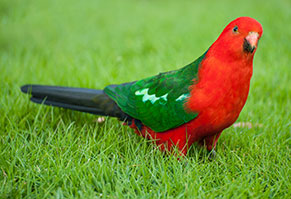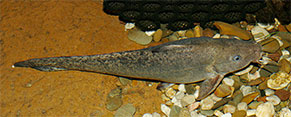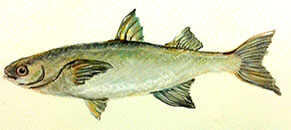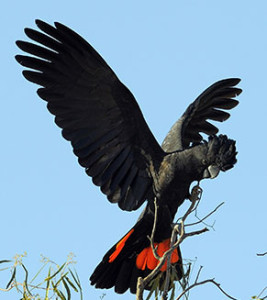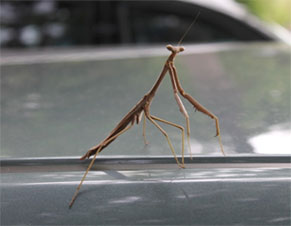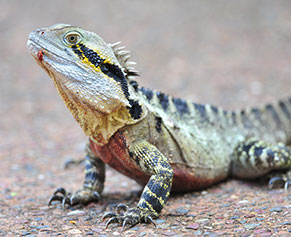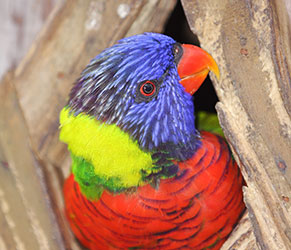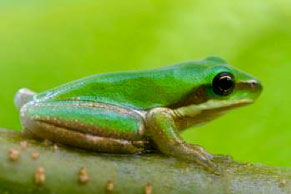
Charlotte Mitchum, age 8
Animals at Fish Creek
Many different types of animals live in and around Fish Creek. In 2014, the Atlas of Living Australia website recorded 3,151 different species of animals living within a 10km radius of Fish Creek. This is an amazing amount of diversity for such a small area!
Australian Brush Turkey
Alectura lathami
Living in rainforests and dry scrub areas from the tip of Cape York down into the central coast of New South Wales, the Australian brush turkey is a common sight around The Gap. The Australian brush turkey likes to spend most time on the ground but will often roost in trees at night.
The brush turkey is quite a large bird, growing up to 75cm long and has a distinctive blue-black coloured, upright, fanlike tail. This bird also has strong legs and a featherless deep red coloured head and neck. The male brush turkeys also have a large, bright yellow wattle that hangs from its neck.
Many a garden and street around The Gap is home to a resident brush turkey (or even group of brush turkeys). Much to the dismay of many a keen local gardener, the male will spend many hours each day determinedly building, rebuilding and maintaining his precious large, round mound of leaves and vegetation for the female to lay eggs in.
Australian King Parrot
Alisterus scapularis
The Australian king parrot is often seen around The Gap local area and also lives all down the East Coast of Australia in rainforests or wet sclerophyll forests. The bright colours of this bird are magnificent! The adult males have a bright red head, breast, and lower undersides; a blue lower back; vibrant green wings and tail; a reddish-orange upper beak with a black tip; a black lower beak; and yellow eye ring. The females look very similar except for a green head and breast; a black upper beak; and paler yellow eye ring.
Bush python
Morelia spilotes
Bush pythons (also sometimes known as Carpet Snakes or the Carpet Python) are a large snake that can grow up to 4m long and can live for more than 20 years. This snake can track and sense other animals to eat, including rats, possums and birds by using special heat-sensitive pits found along their bottom jaw.
Bush pythons mostly live among leaf litter in tree hollows, logs and rocky crevices. Whilst this species of snake is not poisonous, people must always be careful and aware that the bush python (and other species of snakes) live around Fish Creek and The Gap local area. Bush python nests are sometimes found hidden away under piles of woody weeds and other mulch heaped up by bush care activities. Some houses in The Gap even have a resident bush python contentedly living in the roof space!
Common Ringtail Possum
Pseudocheirus peregrinus
The common ringtail possum has rusty-brown coloured sides, a white belly, and a white tipped, short-haired tail. It can often be seen in trees and scuttling along power poles around The Gap during the evening and night. They are a very sociable animal and like to live in family groups.
The common ringtail possum lives in rainforests, shrubby woodlands, eucalypt forests, coastal shrub and suburban gardens (sometimes even in the rooves of houses). When living in their natural environment the common ringtail possum will eat leaves, flower buds and fruits of Australian native trees and bushes. Interestingly, this species of animal is one of only a select few marsupials who are able to feed on eucalypt leaves.
Eel Tailed Catfish
Tandanus tandanus
Provided there has been good rainfall, the eel tailed catfish is a common visitor to waterways around The Gap local area during December. Eel tailed catfish can reach 1m in size, live over 20 years and can weigh as much as 7kg.
This fish can appear as a brown, olive green, reddish or even purplish in colour on the top side and with a paler colour on the under-side. Eel tailed catfish have a short first dorsal fin and an eel-like tail. The second dorsal fin originates above the middle of the body.
Freshwater Mullet
Myxus petardi
Also sometimes called the pink-eye mullet, the freshwater mullet is native to South East Queensland and likes to live in deep, gently flowing sections of rivers. This species also lives in estuaries and coastal seas during spawning events. With silvery sides and belly, a long body, compressed head and small eye the freshwater mullet can grow to an impressive 80cm in length. The freshwater mullet feeds mostly on algae and other plant material present in the water. It will also eat small invertebrates.
Many a local fisherman has very fond memories of spending an afternoon catching freshwater mullet of around 40cm in length up until the early 1960’s. Unfortunately, the changing Fish Creek habitat over time has seen a large reduction in the number of freshwater mullet in our local waterways. We are hopeful that by restoring our local waterway, that the freshwater mullet fish numbers will increase again.
Red-tailed Black Cockatoo
Calyptorhynchus banksii
The Red-tailed Black Cockatoo (also sometimes called the Banksian or Banks’ Black Cockatoo), is a large black bird native to Australia. The adult males have a pair of bright red panels on the tail – a special feature that gives this beautiful animal its name.
Five different subspecies of this bird have been identified, with the main difference being the beak size of the bird. Although the more northerly subspecies of the red-tailed black cockatoo are widespread throughout the drier parts of Australia, the two southern subspecies, the Forest Red-tailed Black Cockatoo and the South Eastern Red-tailed Black Cockatoo are under threat.
Important Note: It is not known if sightings of red-tailed black cockatoos along Fish Creek are the more common subspecies, or those under threat. It could be deduced that those in SEQ are living outside of the drier: areas, and are therefore one of the species that is under threat. To be absolutely certain which species has been observed at Fish Creek, further field work would need to be undertaken.
Richmond Birdwing Butterfly
Ornithoptera richmondia
The Richmond Birdwing Butterfly is one of the largest and most beautiful butterflies to live in South East Queensland and Northern New South Wales.
The male butterfly has brilliant green and black wings and bright red splash on its thorax. Sadly, over the last hundred years or so, Richmond birdwing butterfly numbers have dropped so drastically that this animal is now listed as vulnerable – the same conservation status as the koala.
Restoring the Fish Creek habitat will provide a safe habitat for the Richmond Birdwing Butterfly to live.
Stick Mantid
Archimantis latistyla
Also called a “praying mantid” or “praying mantis”, the stick mantid is a familiar insect that lives around Brisbane and in our local area. This photo of a stick mantid was taken in a car park next to Fish Creek! Adult praying mantids are pale brown, with the females being larger than the males.
Tawny Frogmouth
Podargus strigoides
Sometimes seen around The Gap, the Tawny Frogmouth is an impressive looking bird that is sometimes mistaken for an owl. The Tawny Frogmouth is not a type of owl – rather, it is a relative of nightjars and oilbirds. Tawny Frogmouths make a loud “clacking” sound with their beaks and have a loud reverberating call.
This bird likes to hunt at night and spend the day roosting on a dead log or tree branch close to the tree trunk. It has very large eyes and has excellent hearing, great for helping this bird to quickly and easily locate prey when out-and-about hunting at night.
If you want to see this bird around our local area, you will need to pay attention and look very carefully about you in the trees. This is because the Tawny Frogmouth’s camouflage is excellent — by staying very still and upright, they can look just like part of the branch of a tree.
Water Dragon
Intellagama lesueurii
Water Dragons are a very common around The Gap and along the east coast of Australia. Unlike many other Australian native animals, the water dragon has thrived with urbanisation – they are happy to eat food scraps that people leave behind. The water dragon has a special distinguishing feature of a crest on the nape of the neck and along the backbone. They also have sharp claws and a very strong bite – you would not want to keep one as a pet!
Water dragons are very powerful swimmers and have a special ability of being able to stay underwater for a long time, sometimes up to half an hour. In fact, there have even been some reports that the water dragon can sleep underwater – how amazing!
Rainbow Lorikeet
Trichoglossus haematodus
The bright, beautiful and very noisy Rainbow Lorikeet is often seen (and heard) around The Gap local area. This parrot has a dark blue head and stomach, a vibrant green back, tail and vent, and a red breast and beak. The Rainbow Lorikeet lives along the eastern seaboard of Australia, ranging from Queensland down to South Australia. They also live in northwest Tasmania.
Interestingly, rainbow lorikeets have a tongue that is specially adapted to their special diet of mostly pollen and nectar.
Eastern Sedgefrog
Litoria fallax
Sometimes seen in suburban gardens, the eastern sedgefrog is a small animal that grows to less than 3cm in size.
The eastern sedgefrog tends to live in areas near water along the East Coast of Australia, ranging from North Queensland down into Ulladulla, Southern New South Wales. This cute little frog is a green to pale brown colour with a white jaw stripe. It also has a dark band that goes between the nostril and eye. The back of its thigh is bright orange.
The call of the eastern sedgefrog is a long `wreeek’ followed by two short ‘pips’. It is quite possible that the eastern sedgefrog lives in areas of Fish Creek. They lay eggs in small clumps on the surface of water which then attaches to aquatic vegetation


